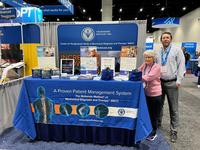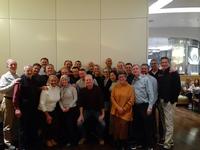News Room
Collaborations Outside PT Benefit Patient Care
The North American Spine Society (NASS) Annual Meeting is the largest gathering of spine surgeons and physicians in the world. So, what in the world was a physical therapist doing there?
That's the kind of reaction Ryan Tauzell, PT, Cert. MDT, expected when he attended his first NASS annual meeting. Instead, he began developing collaborations that would enrich his own knowledge, technique and practice. He has since made appearances as a speaker at the NASS Annual Meeting, chairs the organization's Exercise Committee and serves as a faculty member.
"NASS membership and annual meeting attendees require a trusted source for spine exercise information and that is the role of the Exercise Committee," Tauzell says. His passion is to convey a simple message: “Specific exercises produce value.”
"I must use an acceptable level of evidence," Tauzell says. "It creates opportunities to educate others and hold myself to a higher level of accountability."
He especially enjoys the opportunity to spread the message about the McKenzie Method® of Mechanical Diagnosis and Therapy® (MDT).
“There is a misconception among the majority of spine providers that all exercises are the same and general movement is good, no matter what direction,” Tauzell says. “The direction of movement makes all the difference.”
The evidence-based MDT system begins with a thorough mechanical analysis to establish a "cause-and-effect" relationship between historical pain behavior as well as the response to repeated test movements, positions and activities.
A systematic progression of applied mechanical forces utilizes pain response to monitor changes in motion and function to classify the disorder. Clinicians then develop a treatment program that empowers patients to treat themselves when possible.
Tauzell's passion for solving back problems with MDT provided the impetus for reaching out beyond physical therapy professional organizations. Recent research shows that back pain causes more disability worldwide than some 300 other conditions studied.
"It's safe to say, that the way we've been doing spine care over the past 50 years isn't working," Tauzell says. "The problem is getting bigger very quickly, more money isn't solving the problem, and the usual care method isn't solving the problem.”
The experience with NASS has afforded Tauzell, a partner at Choice Physical Therapy & Wellness with Casey Vedder, DPT, OCS, Cert. MDT, and Daniel Perry, PT, Dip. MDT, out of North Carolina and Virginia, the opportunity to take back pain on at an international level. Vedder and Perry are also active with NASS and outcomes accountability programming with Integrated Mechanical Care (IMC). They collaborate with IMC to ensure they provide the highest value in musculoskeletal care.
"Involvement with quality organizations allows exposure to some of the world's greatest researchers, clinicians and most influential stakeholders," Tauzell says of his experience with NASS and IMC. "They may see something in your presentation they think is intriguing and this starts a conversation."
Intense research is required to prepare an evidence-based presentation that is clinically applicable. So for physical therapy practice owners looking to expand their influence and visibility in the medical world, Tauzell recommends starting the process there.
- Take an inventory of your interests - "It has to be something you're passionate about," Tauzell says. "You're about to delve into something in great detail and spend many unpaid hours." It might be the musculoskeletal disorder you deal with most often or a patient trend you'd like to treat more effectively. The more specific your niche, the greater your focus can be.
- Find an organization - “Simply put, get involved and be willing to spend time and accept responsibility,” Tauzell says. “I started with NASS as an exercise booth volunteer and gradually accepted more responsibility. My goal has never been to rise to a chair position, but to provide a meaningful and clinically applicable learning experience.”
- Reach out - Attend a conference, network with exhibitors and connect with presenters that resonate with your focus. Give your time generously. If this is your passion, it won’t seem like work.
- Get involved - Becoming an exhibitor, presenter or even faculty member may be a natural progression depending on your level of engagement.
Collaborating with peers outside the realm of physical therapy comes with many benefits. It's a chance to challenge others as well as yourself to come up with new ideas and solutions.
Ultimately, you end up with a deeper understanding of your specialty, stronger connections throughout the medical profession and happier patients who benefit from knowledgeable treatment.
Share your news! Send your story to us and we'll post it for everyone to read.




